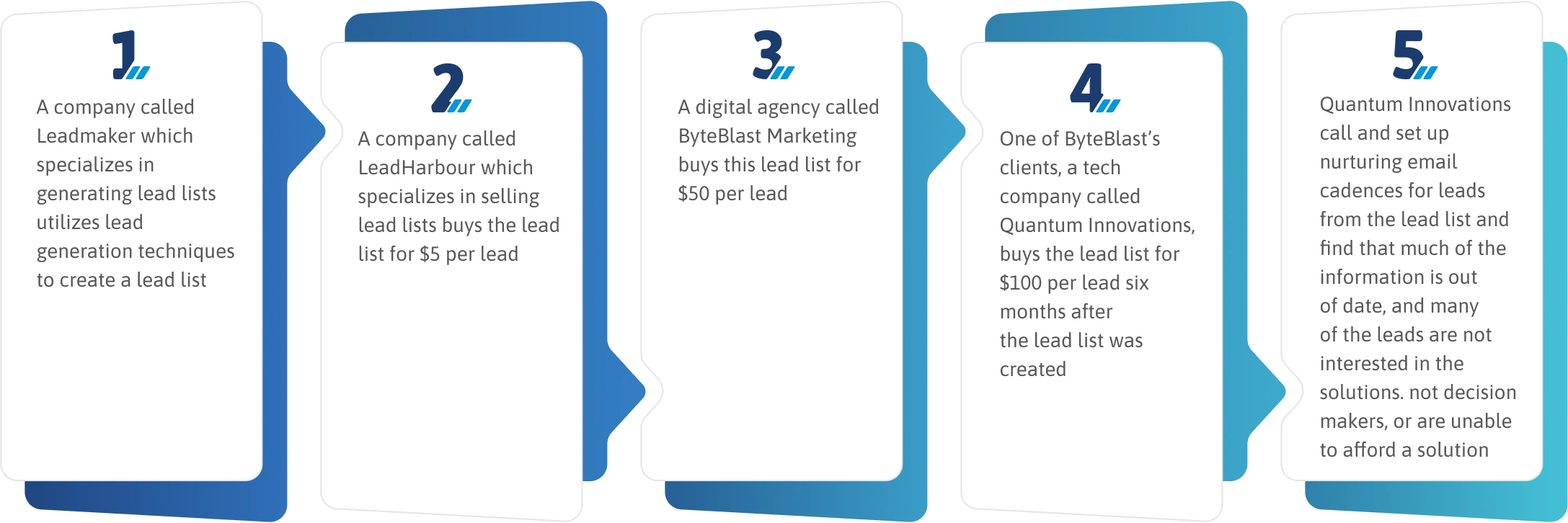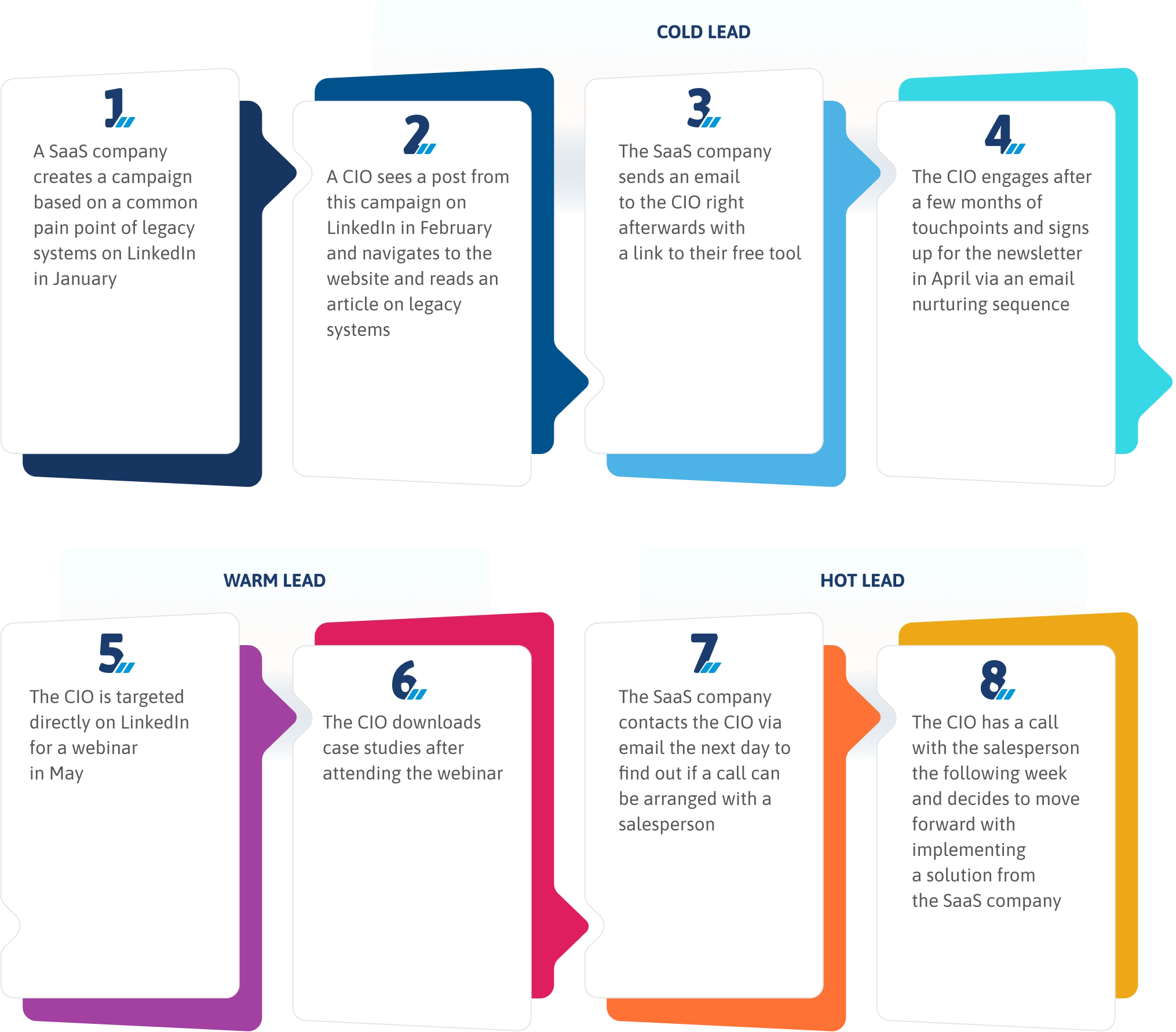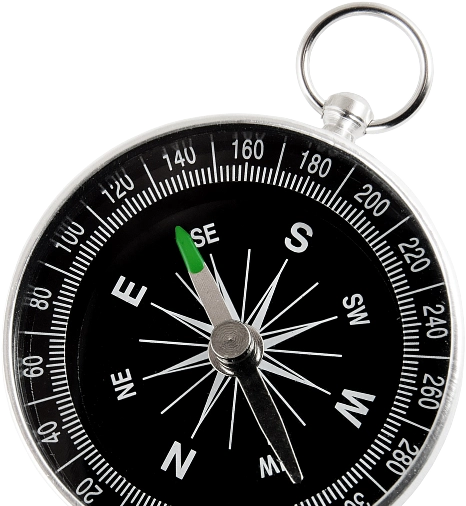Why Demand Generation Generates Better ROI than Lead Lists
10 min

Executive summary
The shift to buyer-controlled journeys has made generic outreach to cold leads both ineffective and expensive. Demand generation delivers superior ROI by synchronizing with real buyer behavior, activating meaningful intent signals, and establishing trust throughout the entire funnel.

Key insights:
What are lead lists?
Lead lists are curated collections of contact information for individuals or businesses who fit specific criteria and are deemed potential prospects for a product or service.
These lists typically include details such as names, email addresses, phone numbers, and demographic or firmographic data. Marketers often purchase lead lists to streamline their outreach efforts and drive velocity at the top of the sales funnel.
Lead Lists

*Note that by the time Quantum Innovations buys the lead list, the lead list is 6 months old and 20x the original price
What is demand generation?
Demand generation is the process of guiding prospects along the buyer’s journey with a brand: from completely unaware to becoming a qualified prospect, and finally, a client.
This requires precise omnichannel targeting, which nurtures relationships with prospects to support the evaluation of the best-fit solution for their needs.
Consistently delivering valuable content and insights across prospects' preferred channels—both digital platforms and offline touchpoints like industry events—maintains engagement and builds relationships with target accounts to drive demand for an organization’s services.
Demand Generation

Demand generation vs. lead lists
B2B buying continues to evolve at a rapid pace. Buying groups are growing in size and complexity, and the average sales cycle now spans between six to twelve months, according to INFUSE Insights Voice of the Buyer 2025, with up to 800 vendor interactions per journey (6sense Buyer Experience Report 2024).
Under these challenging market conditions, many marketers acquire lead lists. These pre-assembled databases offer the promise of speed and scale, but they often come at the expense of quality, relevance, and trust.
91% of marketers consider lead generation as their most important goal (Ruler Analytics, 2023), which is why many B2B organizations still purchase lead data as a quick win. However, 45% of businesses struggle to generate enough leads, and 42% of B2Bs cite low-quality leads as one of their biggest sales challenges (Sopro, 2025).
Meanwhile, advertising budgets are no longer allocated to drive reach alone. Instead, they are backward planned around pipeline contribution and revenue goals. Every dollar spent must deliver a measurable return.
This shift has raised the strategic value of demand generation.
Rather than collecting static contact details, demand generation programs activate real buying groups based on intent, behavior, and buyer journey stage-specific messaging. These factors deliver meaningful engagement from the outset.
When B2B marketers were asked which capabilities were missing from their tech stack, 47% said they lack efficient lead generation and nurturing processes (Content Marketing Institute, 2025) — a clear indicator of the importance of demand generation.
Demand generation supports high-quality engagement from the top of the funnel through to conversion, while also cultivating brand advocacy through post-sale tactics. It builds brand recognition, establishes trust, and reveals in-market accounts through orchestrated omnichannel touchpoints.
This is particularly important given the rise of the dark funnel, where most of the modern B2B buying journey happens. In fact, today’s B2B buyers only initiate first contact when they are 70% through their buying journey (6sense Buyer Experience Report, 2024).
Instead of relying on cold outreach to unknown contacts on a lead list, demand generation empowers buyers to engage on their terms, which often happens well before they appear in Client Relationship Management (CRM) systems. Demand generation also supports prospect nurturing, allowing marketers to personalize communications based on behavior, industry, and role.
Why is demand generation important?
Demand generation plays a critical role in modern B2B marketing, serving as the engine behind pipeline quality, sales efficiency, and long-term client value. In fact, organizations that prioritize demand generation as a strategic function see up to 35% higher marketing-driven revenue (Alexander Group, 2023).
As buying cycles become longer and more decentralized, demand generation provides the framework to meet buyers where they are, and with greater relevance.
“In complex buying scenarios, visibility alone is not enough. Demand generation turns passive interest into qualified engagement by enabling buyers to solve real problems—long before they fill out a form.”

Founder and CEO, INFUSE
Here are some of the key reasons why demand generation delivers a stronger, more sustainable ROI for modern businesses:
B2B demand generation is essential for building awareness and establishing relevance early in the buyer journey. With most of the buying process taking place in the dark funnel, marketers must prioritize visibility and value long before intent is declared.
This is especially important as buyers now engage with content across many touchpoints and interact with multiple stakeholders before their intent is recorded in CRM systems (INFUSE Voice of the Buyer, 2025).
Audiences today rely heavily on self-education during the buying journey. By activating omnichannel strategies, demand generation enables brands to show up consistently and credibly in the spaces their audiences use. This early-stage awareness helps to shape buying criteria and increases the likelihood of being included in the initial shortlist, which influences 85% of final vendor decisions (6sense Buyer Experience Report, 2024).
Lead lists, on the other hand, bypass this critical awareness phase entirely. With no prior engagement or context, cold outreach often represents the buyer’s first and only interaction with the brand. This disconnect leads to lower conversions as trust must be built from scratch in a short period of time.
Most B2B purchases are driven by large buying groups, which means that it is not effective to engage a single lead. Each role within a group has unique priorities, and the buyer experience must reflect that.
Demand generation enables brands to create persona-specific messaging that resonates across segments, from technical stakeholders to the economic decision makers. By delivering content that speaks directly to individual pain points, goals, and buying motivations, businesses can build trust with the full buying group, not just one contact.
This depth of engagement is essential to forming meaningful relationships that drive deal progression. In contrast, lead lists rarely provide this level of insight. Without context or behavioral data on target buying groups, strategies often miss the mark, leading to poor engagement and wasted opportunities.
Effective demand generation does not end at capturing the prospect's details. It nurtures interest and trust across the buying journey, including after a sale.
According to Forrester Research, when implemented correctly, nurturing drives significant ROI: organizations that prioritize prospect nurturing generate 50% more sales-ready leads at a 33% lower cost. Beyond this, organizations that increase client lifetime value (CLV) by just 10% can see up to a 30% boost in overall revenue (Appnova, 2025).
This approach also aligns with the reality of today’s defensive, information-saturated buying groups, who want to progress through the buyer’s journey at their own pace. Demand generation supports this by delivering timely, relevant content that speaks to evolving needs, building trust over time, and increasing the likelihood of conversion when intent surfaces.
5 reasons why lead lists do not deliver ROI
While generating a high volume of prospects may fuel a pipeline and appear valuable on the surface, today’s extended, research-heavy B2B buyer journey means that prospect quality (not quantity) is the true driver of ROI.
Indeed, for 59% of marketers, inbound strategies (such as demand generation) provide the best leads, while only 17% attribute their best leads to traditional practices such as purchased lead lists (HubSpot, 2023).
Here are some of the main reasons why relying on lead lists falls short in both strategy and results:
Outdated, inaccurate, or incomplete information is a persistent issue with third-party sources, resulting in duplicate outreach, irrelevant targeting, and diminished engagement. Indeed, 69% of companies agree that poor data limits their ability to make informed decisions (Huble, 2025).
Beyond wasted time and spend, bad data undermines personalization, something that significantly improves the chances of a successful buying journey. Consider that 90% of buyers are more likely to buy when using rich messaging features, and 81% of clients ignore irrelevant messages (Attentive, 2025). These figures clearly indicate the importance of personalization in today’s buying journey.
Demand generation solves this by enabling organizations to capture and qualify leads based on real-time engagement signals, intent, and behavioral insights. This demand intelligence fuels more effective segmentation, deeper personalization, and stronger campaign performance. This is especially true when activated through Account-Based Experience (ABX) strategies that align content and outreach to each buying group member’s needs.
By focusing on leads that match your ICP and buyer personas, you can maintain data integrity and hygiene from the outset. This approach increases the likelihood of generating higher quality leads with stronger conversion potential. In fact, 68% of B2B marketers credit demand generation with delivering higher-quality leads than traditional methods (Marketo, 2023).

Source: Why The Relationship Funnel Matters: A 4-Step Playbook For Generating Multiple Leads Per Account
Even if the contact information in a purchased lead list is accurate, you are not buying a relationship, but starting from zero.
That makes unsolicited outreach a hard sell. Cold calling has an average success rate of just over 2% (Cognism, 2025), and the vast majority of calls from unknown numbers go unanswered. What is more, 77% of cold B2B sales emails are never opened (Martal Group, 2025). These low-response tactics erode trust, especially when consent has not been given, and personalization is missing.
Meanwhile, through value-first content, personalized omnichannel experiences, and progressive nurturing, demand generation builds authentic connections. Additionally, it enables multithreading, which allows marketing and sales teams to engage multiple decision makers simultaneously.
High-quality lead lists often carry a high price tag, and even then, there is no guarantee that they will perform. Such lists typically include:
While more expensive lists may offer deeper targeting and verification, data still decays quickly. In fact, 70% of data becomes stale within 90 days of its creation (Varonis, 2022) because of role changes and evolving tech stacks. Over time, this stale data loses relevance and disconnects from current business needs, creating greater risk and making compliance more difficult (Proofpoint, 2025).
Purchased lists rarely reflect real buyer intent, and they do not align with today’s self-directed buyer journey that requires precise personalization and timing. This creates a disconnect that undermines campaign performance, even when outreach is accurate.
Cold outreach using purchased lead lists still carries a significant risk of email blacklisting.
Nearly half of all emails (45.37%) are categorized as spam (Statista, 2023). This highlights how sending to unengaged contacts increases the likelihood that your domain ends up on a blocklist, resulting in damaged sender reputation, possible future deliverability issues, and less effective campaigns.
Beyond the technical risk, cold emails contradict how B2B buyers want to engage today. Modern buyers prefer value-led, permission-based interactions, which demand generation enables since it builds trust in the long term through relevant touchpoints. As a result, prospects are naturally more receptive, and your pipeline is more predictable.
With new GDPR amendments introduced in 2025 and stricter enforcement across global regions, privacy regulations are tightening. Violations can now trigger larger fines, greater reputational damage, and legal scrutiny.
Even seemingly reputable providers can obscure data origin and collection methods, making it difficult to confirm whether a contact list meets the requirements of privacy legislation, including (but not limited to):
The burden falls on your team to verify compliance, and the risks are higher than ever.
Demand generation offers a compliant, consent-first approach to gathering prospect data. It ensures all information capture is transparent, permission-based, and aligned to the expectations of today’s privacy-conscious buyers.
Key takeaways
ACTIVATE HIGH-PERFORMANCE DEMAND THAT DRIVES QUALIFIED ENGAGEMENT
INFUSE demand experts design programs that align with your growth goals and engage your best-fit buyers.

